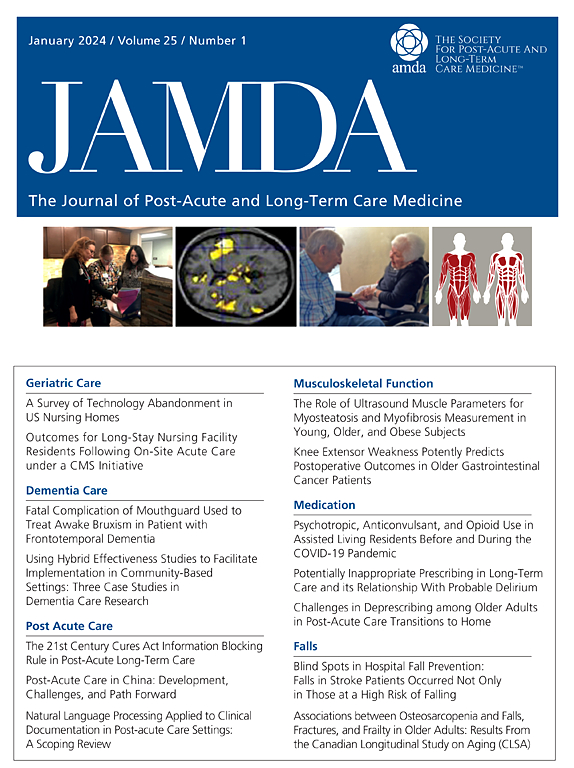长期护理院的医生计费与临终症状管理药物处方的关系:一项基于人群的回顾性队列研究。
IF 4.2
2区 医学
Q2 GERIATRICS & GERONTOLOGY
Journal of the American Medical Directors Association
Pub Date : 2025-07-23
DOI:10.1016/j.jamda.2025.105766
引用次数: 0
摘要
目的:通常需要药物治疗来控制令人痛苦的临终症状(如疼痛、躁动、呼吸困难)。我们评估了长期护理(LTC)的医生计费是否与LTC居民收到临终症状管理药物处方相关。设计:采用行政卫生资料的回顾性队列研究。环境和参与者:安大略省626个公共资助的LTC家庭中,在2017年1月1日至2020年3月17日期间死亡的所有LTC死者都与LTC中最负责他们护理的医生(MRP)相匹配。方法:我们测量的比例MRP的帐单,发生在LTC。使用处方索赔数据,在LTC居民生命的最后2周中捕获1+生命末期症状管理药物的处方。结果:纳入LTC患者54,445例,mrp患者1855例。mrp在LTC的总账单中位数为9%(四分位数范围为3%至23%)。三分之二的LTC死者(36,682,67.4%)至少有一种临终药物处方,其中最常见的是阿片类药物(处方给65.4%的死者)。基于MRP在LTC中账单的比例,死者获得临终药物处方的几率没有差异(LTC中MRP账单增加10%的调整优势比为1.01,95% CI为0.99-1.02)。结论和意义:在安大略省的LTC家庭中,临终症状管理药物的处方率存在很大差异;然而,医生在LTC中所占的比例与更大的开处方的可能性无关。本文章由计算机程序翻译,如有差异,请以英文原文为准。
Physician Billing in Long-Term Care Homes and the Association With the Prescribing of End-of-Life Symptom Management Medications: A Population-Based Retrospective Cohort Study
Objectives
Medications are often needed to manage distressing end-of-life symptoms (eg, pain, agitation, dyspnea). We evaluated whether physician billing in long-term care (LTC) was associated with LTC residents’ receipt of an end-of-life symptom management medication prescription.
Design
Retrospective cohort study using administrative health data.
Setting and Participants
All LTC decedents in Ontario's 626 publicly funded LTC homes who died between January 1, 2017, and March 17, 2020, were matched to a physician most responsible for their care (MRP) in LTC.
Methods
We measured the proportion of an MRP's billings that occurred in LTC. The prescribing of 1+ end-of-life symptom management medications was captured in LTC residents' last 2 weeks of life using prescription claims data.
Results
The study included 54,445 LTC decedents and 1855 MRPs. MRPs had a median of 9% of their total billings in LTC (interquartile range 3% to 23%). Two-thirds of LTC decedents (36,682, 67.4%) had at least one end-of-life medication prescription, the most common of which was opioids (prescribed to 65.4% of decedents). There was no difference in the odds of a decedent having a prescription for an end-of-life medication based on their MRP's proportion of billings in LTC (adjusted odds ratio for a 10% increase in an MRPs' billings in LTC 1.01, 95% CI, 0.99–1.02).
Conclusions and Implications
Across Ontario's LTC homes, there are large variations in prescribing rates for end-of-life symptom management medications; however, a physician's proportion of billings in LTC was not associated with a greater likelihood of prescribing.
求助全文
通过发布文献求助,成功后即可免费获取论文全文。
去求助
来源期刊
CiteScore
11.10
自引率
6.60%
发文量
472
审稿时长
44 days
期刊介绍:
JAMDA, the official journal of AMDA - The Society for Post-Acute and Long-Term Care Medicine, is a leading peer-reviewed publication that offers practical information and research geared towards healthcare professionals in the post-acute and long-term care fields. It is also a valuable resource for policy-makers, organizational leaders, educators, and advocates.
The journal provides essential information for various healthcare professionals such as medical directors, attending physicians, nurses, consultant pharmacists, geriatric psychiatrists, nurse practitioners, physician assistants, physical and occupational therapists, social workers, and others involved in providing, overseeing, and promoting quality

 求助内容:
求助内容: 应助结果提醒方式:
应助结果提醒方式:


